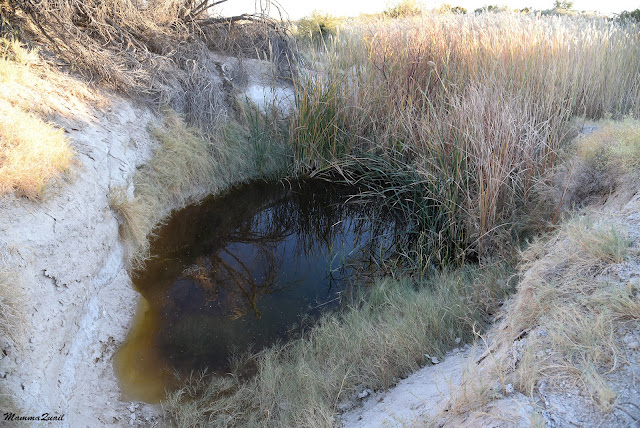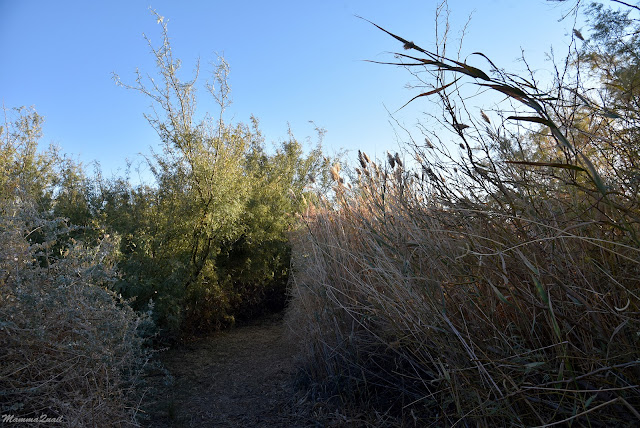Date: November 25, 2021
Place: Shoshone Nature Trail, Shoshone Village, California
Coordinates: 35.974878, -116.269928
Length: 2.5 miles
Level: easy
Place: Shoshone Nature Trail, Shoshone Village, California
Coordinates: 35.974878, -116.269928
Length: 2.5 miles
Level: easy
The day after we moved in Death Valley National Park for the rest of our 2021 Thanksgiving vacation we decided to dedicate to birding east of the park's boundaries. The elder chika was still a bit down from her illness earlier that week and needed one more day of easy walks. We spent the morning wandering around Ash Meadows Preserve east of the park looking for birds there, but didn't see much. We also checked out a bit of Death Valley National Park that is a tiny island of parkland nestled inside the Ash Meadow Preserve area, called Devil's Hole. Devil's Hole is a huge underground cavern that is fully flooded and is home to endemic fish species. We could only look at the cave from outside the fence that surrounded the hole.
After Ash Meadows we drove to Shoshone to hike a Shoshone Nature Trail that I read about in the local Audubon Society chapter's website. Before the hike we dropped into the local diner for lunch and while we were outside the diner we saw a cute roadrunner checking out the place's front yard.
 |
| Roadrunner |
The trailhead was right behind the diner so after our lunch all that we needed was to get our water bottles and cameras and head out toward the river.
 |
| Our hike as captured by my GPS |
Just like in Ash Meadows, it seemed right away that we were there at the wrong season for birding. Unlike Ash Meadows however, this place had other nice aspects that made our hike there a very nice one. One problem we had that hike though, was that the trail markers did not seem to fit the markings on the map I had of the trail, so the loop we ended up hiking didn't match the recommendation on either the Audubon Society page or the AllTrails entry.
 |
| Shoshone Nature Trailhead |
We started on a short bit of trail leading from the road to the Amaragosa River. I don't know the name of the mountain range east of Shoshone, but it was a very beautiful mountain range, with nice, even, and very colorful sedimentary rock layers that were very visible from afar.
Pappa Quail and the elder chika who were looking for birds all day found a couple of bluebirds on a tree branch a bit farther away and stopped to take photos. Bluebirds are always fun to see, even if they're common and can be seen also in the Bay Area.
 |
| Western Bluebird, male |
My camera isn't suitable for far away birding so I enjoyed the bluebirds through my binoculars. I was also fascinated by the red balls of mistletoe that decorated just about every other tree in the area.
A bit further down the trail my family borders found a sparrow. They saw a few phainopepla too but these were too far away and wouldn't cooperate with the cameras.
 |
| Juvenile white-crowned sparrow |
West of the Amaragosa River there are a couple of short loops in the trail and we veered off to one of them. i let my family go up ahead and I took the view of the area east of us. Most of the vegetation was yellowish-gray but there was a thin green line of lusher vegetation that marked where the river, the water lifeline of the area, was.
On the nature loop we took the trail plunged into a thicket of small mesquite trees and large holly bushes. It was nice to have some shade on the trail because even the November sun is intense in that region, and it was good to have some respite from the wind that had picked up in the afternoon. In some places we had to stoop down to go under the boughs that hanged over the trail.
When we got clear of the vegetation we had a nice view of the Amaragosa Range to the west. A large DV letters were chalk-painted on the mountain side. I assume it stands for Death Valley. Only yesterday we hiked at the 'Hole in the Wall' on the other side f those peaks.
Large holly bushes flanked our trail and every now and then I picked myself a leaf and munched on it. These plants do well on saline soils because they have a mechanism to secrete the salt out of the leaves. The leaves therefore, taste salty. They are also bitter, so I only chewed one at the time.
My young chika waited for me to catch up with her and pointed at the ground where there were a few active anthills. Small wildlife is still wildlife, and ants are fascinating.
We completed the loop and resumed our walk to the river, then turned to follow it north. All that time we didn't see any birds other than bluebirds and sparrows, and an occasional phainopepla. The view was nice, though. I imagine that in spring the wildflowers are pretty there.
It wasn't very late in the afternoon but it was the short-days time of the year and the shadows were getting long already. My shadow stretched long to the northeast over the river side grasses.
The grasses were very pretty, even when completely dry. I don'y know to identify grasses very well and I didn't try to identify these. I don't even know if they are native or exotic to the area. I did like the fluffy look they gave the river bank.
Amaragosa River has some water holes that had water in them still, but for the most part it looked dry. It might also have been so because of the drought. California fan palms indicated the presence of fresh water. The vegetation was too thick to see any there. At some point we crossed the river and continued north along the eastern bank.
 |
| Amaragosa River |
The map I had with me marked a return trail that loops back along the road. When we reached the road again about a mile and some north of where we started, we saw no trail going back. After some looking around behind a resort where said trail was supposed to be, and not finding anything, we backtracked our steps to the river trail.
We thought to go back on the same trail we came on, but Pappa Quail found another trail that loops back further east of the river, so we took that trail. We had to go a bit further north before the trail curved south, and I got to see the other side of that pretty fan palm we saw earlier on the hike.
The mountains to the northeast were significantly smaller than the Amaragosa mountains, but they looked very pretty and inviting. We didn't have the time to explore them that day but I did look at them wistfully and hoped I could go back there one day.
The trail finally curved south and we plunged into tall vegetation again. Among the river bank plants there I recognized the common reed, a highly invasive species I'm all too familiar with from the Middle East.
I saw a lush and healthy young fan palm nestled among the mesquite. I guess that one too indicates the presence of fresh water close to the ground.
 |
| California Fan Palm |
Nearing the end of November, I didn't expect to see any wildflowers on this hike. I was surprised therefore, to see a rabbitbrush blooming. But if there was anything that would be blooming there in this time of year, of course it would be of the aster family.
 |
| Rabbitbrush |
The trail separated from the river and led us closer to the low hills on the east of the preserve. Not meandering through vegetation anymore, we picked our pace and were getting near the southern crossing of the river again.
On our way back we crossed the river at a different point. The crossing was right over one of the water holes, and it was in fact, the only tie I saw the river's water on this hike. I figure it flows really nice after a good, rainy season. Certainly well enough to support all the vegetation we saw there.
 |
| Water Hole at the Amaragosa River |
The way back was a quick one. We took the south arm of the second trail loop, where we came upon a few more bluebirds and sparrows. When we finished the hike there was enough daylight to get back to our campground, but our dinner we cooked under lantern light already. At the end of the evening Pappa Quail and the chikas entered the tent right away but I stayed outside. The wind was too strong to have a campfire so we didn't have one. I walked around the campground that was slowly quieting down, and looked up at the magnificent night skies, enjoying once again the brilliant stars and the stunning Milky Way that we're part of, but don't get to see anymore in the urban area where we live.














































